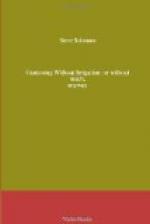Foliar feeding is another water-wise technique that keeps plants growing through the summer. Soluble nutrients sprayed on plant leaves are rapidly taken into the vascular system. Unfortunately, dilute nutrient solutions that won’t burn leaves only provoke a strong growth response for 3 to 5 days. Optimally, foliar nutrition must be applied weekly or even more frequently. To efficiently spray a garden larger than a few hundred square feet, I suggest buying an industrial-grade, 3-gallon backpack sprayer with a side-handle pump. Approximate cost as of this writing was $80. The store that sells it (probably a farm supply store) will also support you with a complete assortment of inexpensive nozzles that can vary the rate of emission and the spray pattern. High-quality equipment like this outlasts many, many cheaper and smaller sprayers designed for the consumer market, and replacement parts are also available. Keep in mind that consumer merchandise is designed to be consumed; stuff made for farming is built to last.
Increasing Soil Fertility Saves Water
Does crop growth equal water use? Most people would say this statement seems likely to be true.
Actually, faster-growing crops use much less soil moisture than slower-growing ones. As early as 1882 it was determined that less water is required to produce a pound of plant material when soil is fertilized than when it is not fertilized. One experiment required 1,100 pounds of water to grow 1 pound of dry matter on infertile soil, but only 575 pounds of water to produce a pound of dry matter on rich land. Perhaps the single most important thing a water-wise gardener can do is to increase the fertility of the soil, especially the subsoil.
Poor plant nutrition increases the water cost of every pound of dry matter produced.
Using foliar fertilizers requires a little caution and forethought. Spinach, beet, and chard leaves seem particularly sensitive to foliars (and even to organic insecticides) and may be damaged by even half-strength applications. And the cabbage family coats its leaf surfaces with a waxy, moisture-retentive sealant that makes sprays bead up and run off rather than stick and be absorbed. Mixing foliar feed solutions with a little spreader/sticker, Safer’s Soap, or, if bugs are also a problem, with a liquid organic insecticide like Red Arrow (a pyrethrum-rotenone mix), eliminates surface tension and allows the fertilizer to have an effect on brassicas.
Sadly, in terms of nutrient balance, the poorest foliar sprays are organic. That’s because it is nearly impossible to get significant quantities of phosphorus or calcium into solution using any combination of fish emulsion and seaweed or liquid kelp. The most useful possible organic foliar is 1/2 to 1 tablespoon each of fish emulsion and liquid seaweed concentrate per gallon of water.




